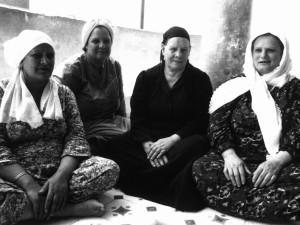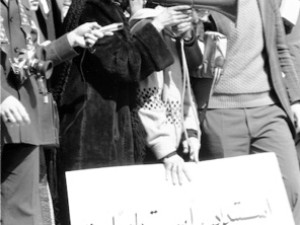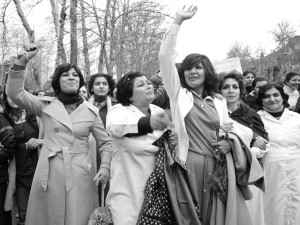
Symposium: When does a Revolution Start? Part I
Saturday 5 September 2015, 12–5pm
Free, tickets available via Eventbrite
‘Women have been veiled and unveiled by force but they will remain enfolded and covered by physical and psychological traces of their modes of acceptance or rejection of the veil’ - Farzaneh Milani.
The condition of unveiling (1936) or veiling (1979) has been imposed on women in Iran by political powers for the last 80 years, as a result women have been deeply concerned with the notions of exposure and concealment for some time. What should be remembered is that, whilst these physical conditions appeared overnight, the individual psychological and emotional response has obviously not followed the same timeline. Farzaneh Milani’s description of women responding to veiling in its physical and metaphorical forms brings to attention a very contemporary concern surrounding veiling.
The unique photographs by Hengameh Golestan show women protesting on the 8th of March 1979, after Ruhollah Khomeini’s decree on the compulsory hijab. This is the most important day of the feminist movement in Iran where women spontaneously came out onto the streets to protest against the decision.
This two-day symposium at The Showroom will address different works and discourses around this period of history and its resonances today. It will focus on discussions around gender, protest and representation through academic papers and artistic practices responding to the event and to start mapping a wider understanding.
Part II will be held at The Showroom on 19 September 2015.
This is an event to accompany the exhibition Hengameh Golestan: Witness 1979
Programme
12–1pm: Professor Reina Lewis, The politics of the veil: the politics of representation.
Hengameh Golestan’s photographs of disputes about veiling in Iran provide an indispensable lens through which to consider the politics that surround veiling in all its forms. This paper addresses the politics of representing women’s use/rejection/accommodation of veiling practices in different spatial and historical circumstances. The circumstances in which the documentary and fine art practices of artists such as Golestan can be commodified, commissioned, distributed and consumed are considered in tandem with the circumstances and exigencies that impact on the production and dissemination of academic research about women, veiling, and religiously related dress.
1–2pm: Artist Sandra Schaefer on the Set of 1978ff followed by Q&A with Louise Shelley
The Iranian Revolution in 1978/79 led to the toppling of the Shah regime. Shortly afterwards, the Islamic Republic of Iran was proclaimed. A broad base of leftists and workers, slum dwellers and peasants, members of the middle class—including feminists—and the clergy support the revolution, which was internationally also interpreted as anti-monarchic, anti-imperialist, nationalistic and/or religious.
In the video installation, on the set of 1978ff, I pursue the questions of why at this point in time political Islam played such an important role and why the foundation of the Islamic Republic was advocated by so many people with different political convictions and from different factions. I regard the Iranian Revolution not as a purely national event but expand the view to interconnections, perspectives and modes of reception in the neighboring countries, the Middle East and the Global North.
I reconstruct the Iranian Revolution both exemplarily and fragmentarily as an urban phenomenon based on its representation in film, television and photography. From the perspective of media production and reception, I am engaged along with further participants in a re-reading of the events. The focus is on processes of handing down and of translation into different contexts.
The two-channel installation, on the set of 1978ff, integrates contributions from West and East German television, BBC Persian, Time Magazine, pictures by photographers Hengameh and Kaveh Golestan, excerpts from the documentary Schah Matt by Thomas Giefer and Ulrich Tilgner, as well as sequences on the intellectual Ali Shariati. I interweave the historical material with interview passages, excerpts from staged public debates and text commentaries.
The screening will be followed by a conversation between filmmaker Sandra Schäfer and photographer Hengameh Golestan who was an important counterpart during the making of ‘on the set of 1978ff’. The conversation will be moderated by Louise Shelley.
2–2.15pm: Break
2.15–3.15pm: Hengameh Golestan in conversation with Azadeh Fatehrad
3.15–4.15: Panel discussion: Professor Reina Lewis, Sandra Schaefer, Hengameh Golestan chaired by Louise Shelley and Azadeh Fatehrad.
5pm: End
Related

Event
Screening: Hidden Faces by Kim Longinotto

Event
Symposium: When does a Revolution Start? Part II

Event
Open discussion with Hengameh Golestan and Justice for Domestic Workers

Exhibition
Hengameh Golestan: Witness 1979
–
Film looking at The Showroom’s local work
Video
Film looking at The Showroom’s local work